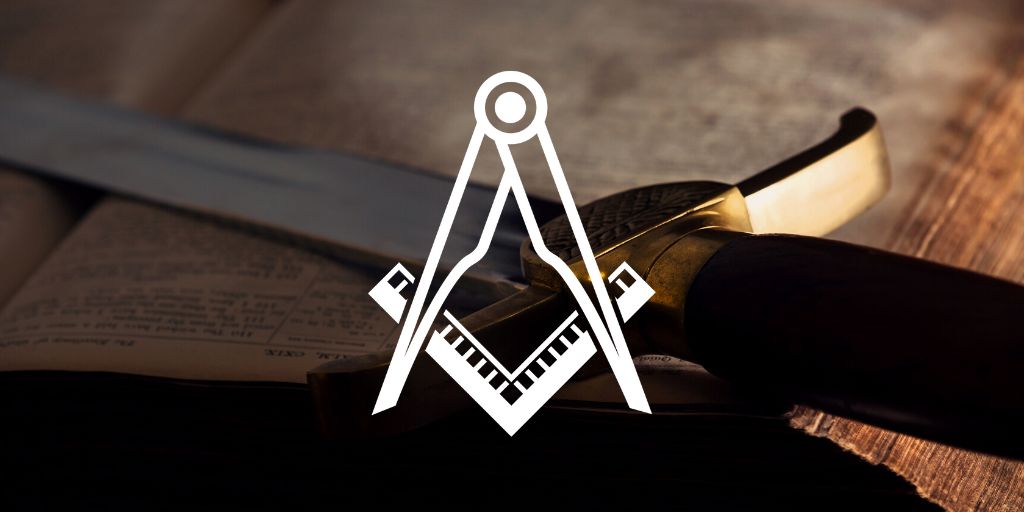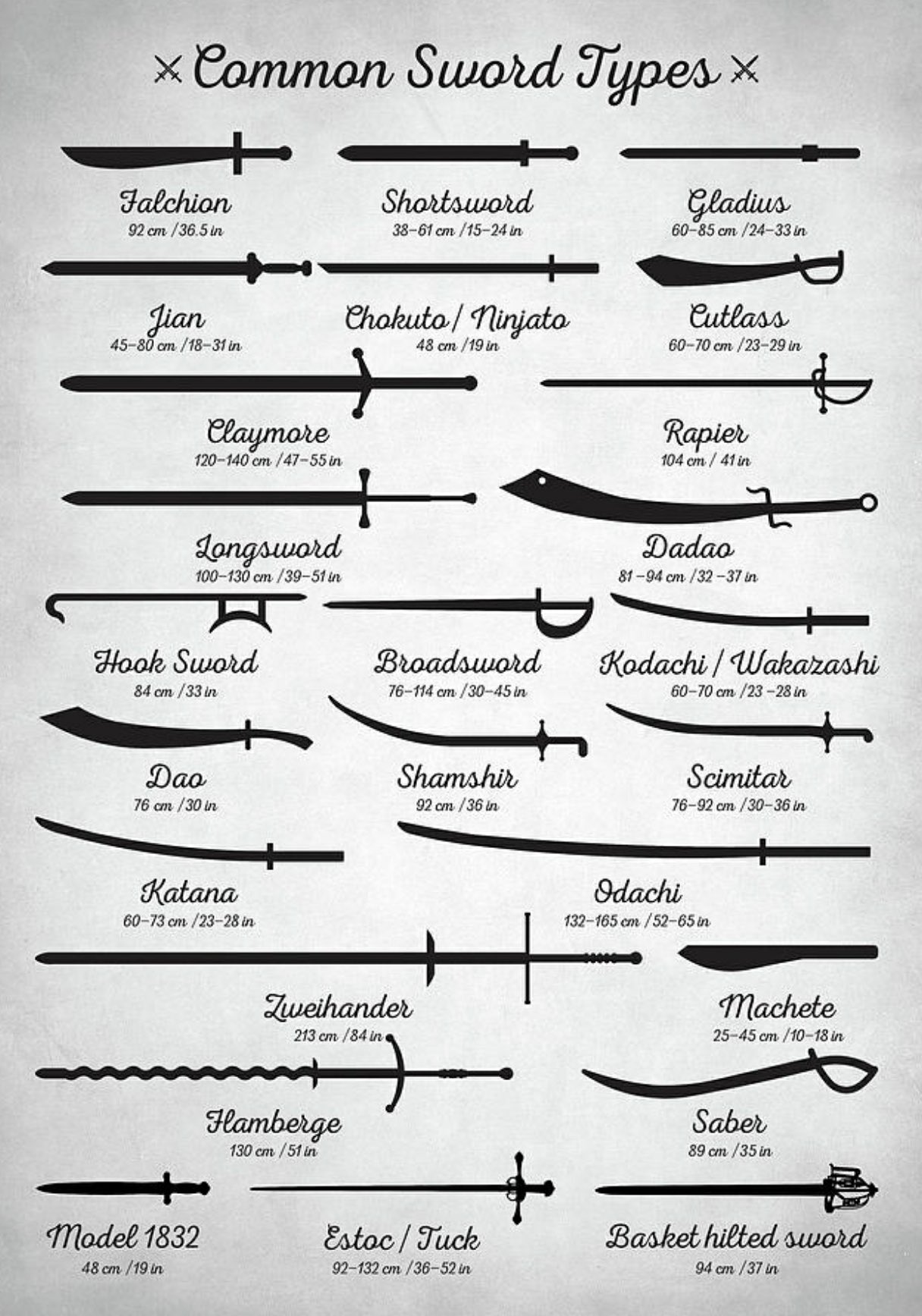Freemasonry, a fraternity rich in symbolism and tradition, has long cherished the sword as a significant ceremonial object, embodying principles of justice, protection, and moral integrity
In this article, we delve into the diverse and intriguing array of swords. From Tyler’s sword to the broad and mighty Scottish Claymore to the sleek and elegant Japanese Katana.
Each sword we discuss is not just a piece of metal crafted for battle; it is a storied artifact imbued with history and significance.
These swords carry a narrative of chivalry, valor, and craftsmanship.
Join us on this journey through time and tradition as we explore the historical significance, unique features, and symbolic value of these remarkable swords.
Whether you are a seasoned Freemason or simply an enthusiast of historical weaponry, this guide will enrich your understanding of the most common and famous sword types.


The Falchion
The Falchion, a medieval sword, is recognized for its single-edged blade that blends the power of an axe and the finesse of a sword.
Its practical design evolved to be favored by knights and foot soldiers.
There are two types: Cleaver Falchions, with broad, cleaver-like blades ideal for chopping, and Cusped Falchions, featuring an elegant curve and a distinctive cusp at the back, possibly influenced by Turko-Mongol designs.
Its key features include a slightly curved blade, a typical sword grip handle, and its efficiency in chopping and slicing.
The Shortsword
The shortsword, a compact and versatile blade, was a popular sidearm for knights and warriors.
This light, one-handed weapon is under 24 inches in length, known for its agility and ease of handling.
Medieval Arming Swords and the Roman Gladius are notable examples.
Key characteristics of the shortsword include a length typically under 24 inches, a lightweight design for swift movements, and a simple hilt accompanying a straight or slightly curved blade.
The Gladius
The Gladius, symbolic of Roman might and efficiency, is ideal for close-quarters combat.
It comes in several types: the Spanish-influenced Republican Gladius, the Mainz Gladius with its waisted blade and long point, and the shorter Pompeian Gladius, popular during the late Republic to early Empire.
The Gladius is characterized by a straight, double-edged blade suitable for striking and thrusting and a handle made from materials like bone, wood, or ivory.
The Cutlass
The cutlass, synonymous with piracy and maritime adventure, was a practical choice for sailors because it was suitable for close-quarter battles on ships.
Key features include a short, often slightly curved blade, a single-edged design for slashing and hacking, and a sturdy guard for hand protection.
Beyond combat, the cutlass served as a multifunctional tool at sea, integral to a sailor’s survival.
The Chokuto
Originating from Japan, the Chokuto is a straight, single-edged sword predating the curved Katana.
Its design, influenced by ancient Chinese swords, reflects early Japanese swordsmithing.
The Chokuto, primarily used on foot and often carried hung from the waist, symbolizes the craftsmanship and martial philosophy of early Japan. Its blade is straight, unlike the curved Katana, and was crafted before the 10th century.
The Jian
The Jian, an ancient Chinese sword, stands out for its double-edged blade.
Known for over 2,500 years, it has been a symbol of nobility and martial prowess.
The Jian’s key features include its origin dating back to multiple Chinese dynasties, a straight design linked with skill in martial arts, and its dual function as both a weapon and a ceremonial piece.
The Claymore
The Scottish Claymore, a massive two-handed sword, is a hallmark of Scottish heritage.
Used from the 15th to 17th centuries, it’s distinguished by its size and distinctive design, including a cross-hilt with forward-angled arms and a lobed pommel.
The Claymore symbolizes power and aristocracy, reflecting skillful swordsmanship.
The Rapier
The rapier, a slender sword from the early 16th century, was used for dueling and self-defense, emphasizing thrusting over slashing.
It features ornate hilts like the swept-hilt and cup-hilt, providing hand protection and showcasing the owner’s finesse and status.
Key aspects include a total length of approximately 123 cm, a blade length around 108 cm, and a weight of about 1.25 kg.
The Longsword
Symbolizing power, discipline, and chivalry, the longsword was used between the 14th and 16th centuries.
It features a straight, double-edged blade designed for cutting and thrusting.
The longsword’s attributes include a blade length of 80-110 cm, a handle of 15-30 cm for two-handed use, and a weight of approximately 1- 1.5 kg.
It is a symbol of justice, authority, and personal responsibility.
The Dadao
The Dadao, a broad Chinese sword similar to a machete, gained prominence in the early 20th century, especially during the Second Sino-Japanese War.
Used by Chinese military forces, its blade is over two feet long with a handle designed for a two-handed grip.
The Dadao is a cultural icon in martial arts and popular culture, symbolizing more than just a weapon.
The Hook Sword
The Hook Sword, another traditional Chinese weapon, is known for its unique design and versatility in combat.
It features a hook for trapping or slicing, a secondary back hook, a crescent guard for hand protection and offensive capabilities, and a linking ring enabling two swords to be connected for extended reach.
Ideal for fluid motion and acrobatic versatility, it symbolizes agility and precision.
The Broadsword
The Broadsword, used for various wide-bladed European swords, balances heft and usability.
Its blade is broad compared to contemporaneous swords, designed for cutting and thrusting, and typically weighs between 3 to 5 pounds.
Notable variants include the English Mortuary Sword, the Scottish Basket-Hilted Sword, and the Venetian Schiavona, each featuring distinctive guards.
The broadsword represents honor, and chivalry is often used ceremonially.
The Kodachi
The Kodachi, a Japanese short sword, offers insight into samurai culture and feudal Japan.
Shorter than the Katana, it often accompanied a longer sword as part of the Daishō, symbolizing status and used primarily by samurai.
The Kodachi’s versatility in confined combat situations makes it an emblem of samurai skill and honor.
The Scimitar
The Scimitar, with its distinct curved blade, symbolizes Middle Eastern warrior tradition.
It originated in the Middle East and was adopted across South Asian and North African cultures.
The design is single-edged with a convex curve for effective slashing.
Variants include the Persian Shamshir, the Indian Talwar, and the Turkish/Ottoman Kilij, each known for combat efficiency.
The Scimitar’s historical contexts enrich its symbolic significance.
The Shamshir
The Shamshir is a Persian sword known for its deeply curved, slender blade, which is primarily used as a slashing weapon.
It originated in Persia (Iran) and features a cross-guard and a pommel for effective handling.
Variants include the Kilij, Talwar, and Nimcha, all sharing the iconic curve.
The Shamshir is a status symbol, often ornately decorated to reflect the owner’s standing.
The Dao
The Dao, a traditional Chinese sword, is renowned for its single-edged blade and historical significance, exemplifying martial virtue.
Key attributes include a single-edged blade ideal for slashing and chopping, length variability, and a gentle curve for swift strikes.
Notable types are the Tang Dao, with a narrow blade and long handle, and the Duan Dao, a short saber typically concealed within clothing.
The Dao symbolizes a fusion of functionality and ceremonial importance.
The Katana
The infamous Katana, a traditional Japanese sword, symbolizes the samurai, known for its curved, single-edged blade and distinctive craftsmanship.
Its characteristics include a length of 23.6 to 29.5 inches, construction from high-carbon steel known as tamahagane, and a style of being worn edge-up, contrasting European swords.
The katana represents samurai values like honor and discipline.
The Odachi
The Odachi, another large Japanese sword, is known for its significant size and use by samurai on horseback or in ceremonies.
Its features include a blade length typically exceeding 90 centimeters, a long handle for a two-handed grip, and a weight heavier than a standard katana.
The Odachi is a testament to the craftsmanship and traditions of the samurai era.
The Machete
The Machete, commonly used in agriculture, is a robust, cleaver-like tool with a significant cultural impact.
Its blade length is around 45 to 60 centimeters, with a straight-backed or curved shape and a handle designed for a firm grip. Variants like the Kukri, Panga, and Parang reflect its global influence.
The machete symbolizes strength and endurance across cultures.
The Zweihänder
The Zweihänder, a large Renaissance sword, was known for its formidable size and use by skilled soldiers like the German Landsknechte.
Its attributes include a weight over 2 kg, a length around 1.4 meters, and a grip width of approximately 25 cm.
The Zweihänder played a significant role in European battlefields, symbolizing martial prowess.
The Flamberge
Known for its wavy blade resembling flames, the Flamberge combines artistic design with functionality.
It was used both in battle and as a ceremonial piece.
The blade is characterized by a distinctive, flame-like wavy pattern and is primarily used two-handed, though some versions are adapted for one-handed use.
Historically significant, the Flamberge symbolizes protection and enlightenment.
The Saber
The Saber, a curved sword, was primarily used by cavalry officers.
Optimized for slashing, it features a curved, single-edged blade and an often ornate hilt with a cross-guard.
The saber may include Masonic symbols and inscriptions, symbolizing strength and chivalry in ceremonial contexts.
The Basket Hilted Sword
The Basket-Hilted Sword is a type of European sword characterized by its distinctive protective guard that wraps around the hand.
This guard, resembling a basket, is crafted from metal bars or plates, providing comprehensive protection to the wielder’s hand during combat.
Emerging in the late 16th century, the design became particularly popular in Scotland and England.
The Model 1832 Foot Artillery Sword
The Model 1832 Foot Artillery Sword, a historical American military sword, was first contracted by the U.S. with the Ames Manufacturing Company, inspired by French designs.
Key features include a blade length of typically 19 inches, a solid brass hilt about 6 inches in length, and a crossguard approximately 4 inches long.
This sword symbolizes the evolution of military equipment and early 19th-century American craftsmanship.
The Estoc / Tuck
The Estoc, also known as the “Tuck,” was a thrusting sword used against opponents in plate armor.
Its design, long, straight, and pointed without a cutting edge, was a response to advancements in armor technology.
The Estoc represents historical weaponsmithing ingenuity and how practical needs shape weapon design.
Which Swords Are Commonly Used in Masonic Lodges?
The types of swords commonly used in Masonic lodges, particularly by officers such as the Inner Guard, may vary depending on the jurisdiction and specific traditions of the lodge.
However, a few types are commonly seen:
- The Jian
- The Claymore
- The Rapier
- The Longsword
- The Broadsword
- The Zweihänder
- The Estoc